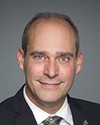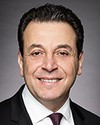Make it quick, Guy.
Evidence of meeting #13 for Finance in the 42nd Parliament, 1st Session. (The original version is on Parliament’s site, as are the minutes.) The winning word was rate.
A recording is available from Parliament.
Evidence of meeting #13 for Finance in the 42nd Parliament, 1st Session. (The original version is on Parliament’s site, as are the minutes.) The winning word was rate.
A recording is available from Parliament.
NDP

Guy Caron NDP Rimouski-Neigette—Témiscouata—Les Basques, QC
I would like to go back very quickly to the TFSA.
Once again, on the matter of the TFSA, I am basing my comments on the report of the Parliamentary Budget Officer and on the general fiscal impact of the changes that had been proposed by the Conservative government. These changes generated an interesting figure as to their long-term impact on the GDP.
For the years 2050, 2060, 2070 and 2080, the Parliamentary Budget Officer forecast a tax cost of approximately 0.6% to 0.7% of the GDP. These tax expenditures would have been generated by the increase in the maximum contribution to TFSAs. Do you remember those figures?
NDP
General Director, Tax Policy Branch, Department of Finance
I can't really comment on that. We have no point of comparison up to 2080.
NDP

Guy Caron NDP Rimouski-Neigette—Témiscouata—Les Basques, QC
Have you done such a study? Are the data on this impact available from the Department of Finance?
General Director, Tax Policy Branch, Department of Finance
Yes. In fact, we mentioned that in 2009, when the government created the TFSA, we were talking about a cost, in current dollars, of $3 billion over 20 years. I could let you know what this means in terms of the GDP. That is how we present it. However, I don't want to give you any figures right now, in case I am mistaken.
NDP

Guy Caron NDP Rimouski-Neigette—Témiscouata—Les Basques, QC
I would really appreciate your sending them to us eventually.
Thank you.
Liberal
Liberal

Robert-Falcon Ouellette Liberal Winnipeg Centre, MB
Thank you very much, Mr. Chair.
I simply want to mention that out of 11 million people, only 6.7 % of Canadians have reached the TFSA deposit ceiling. It is important to have a balanced retirement system. The TFSA is an important tool for retirement planning, but we must not forget that 23 million Canadians do not have a TFSA.
I'd like to just ask a question, though.
To what extent is it likely that the proposed reduction in the second marginal tax rate would result in an increased household consumption? If consumption were to increase, what would be the expected impact on economic growth?
General Director, Tax Policy Branch, Department of Finance
The multiplier used by Finance for this type of tax reduction is about 0.2 over the short term and 0.6 over the long term. Compared with other multipliers, it's relatively smaller. The net amount of benefits, which is about $1.4 billion, provided through that tax cut using that multiplier would not, I think, lead to a very significant proportion of GDP. It would probably be rounded to almost zero. That's all I can tell you.
Liberal

Robert-Falcon Ouellette Liberal Winnipeg Centre, MB
Have any studies been done of the likely extent to which high-income earners would engage in tax avoidance strategies in the event that the proposed top marginal personal income tax rate of 33% is enacted? What would be the most likely tax avoidance strategies, and what are the likely federal responses, if the extent of tax avoidance grows?
General Director, Tax Policy Branch, Department of Finance
By using for analysis that 0.4, we are capturing the possibility of taxpayers using different strategies to try to avoid or delay their tax liabilities.
There are very simple and common ways to do it. For instance, if you're a small business owner, you can retain a bit more of your income in your corporation and decide to delay the distribution a bit. You can decide to postpone particular transactions that would have led to capital gains realization. You can decide to change your savings portfolio composition to a bit less interest income and a bit more capital gains and a bit more dividends. There are a number of ways you can do it without even appearing very aggressive.
You also have probably other moves. You can start using a bit more of some special features of the tax system that are allowed to you, either because there's a special credit or it allows you to delay the realization of income.
Conservative

Ziad Aboultaif Conservative Edmonton Manning, AB
I have a question on income over $217,000. What would the financial impact be on revenue for the upcoming years, starting in 2016-17 and going onward? Can you advise us on this number, please?
General Director, Tax Policy Branch, Department of Finance
The revenues generated by the 33% tax rate would be about $2 billion in 2016-17, $2.155 billion the following year, $2.295 billion in 2018-19, $2.44 billion in 2020, and $2.59 billion in 2020-21.
Conservative

Ziad Aboultaif Conservative Edmonton Manning, AB
Do you have any explanation for those increases which are very little for the second year after 2016-2017, a big jump for the year after, then a drop, then almost level?
Is there any calculation that down the road these incomes may drop and that the final income will be less than what you've anticipated?
General Director, Tax Policy Branch, Department of Finance
Sorry, the income expected is about $2 billion in 2016-2017, and it goes up to $2.6 billion in 2020-2021.
Conservative

Ziad Aboultaif Conservative Edmonton Manning, AB
I understand that. Although there is, as I said, a small increase in the second year, and a bigger increase in the third year, which is about a 30% jump from the year before, have you calculated that maybe those incomes, those reported incomes of $217,000 plus, could be less than anticipated coming into the system? In other words, do we see a drop in income down the road? Have you taken that into the calculation at some point?
General Director, Tax Policy Branch, Department of Finance
This is based on the Department of Finance's projection of different types of income sources, for instance, dividend income, capital gains income, and, ordinary interest income or wage.
The $200,000 bracket will be indexed to inflation, however, these sources of income tend to have growth rates beyond inflation. There will be what we call a bit of bracket creeping, that is, individuals who would see higher tax being paid just because their sources of income have increased at a pace that is greater than the indexation, so they will pay a bit more. Therefore, the acceleration factor you may see is in part due to that aspect of the methodology or the assumptions.
Conservative

Ziad Aboultaif Conservative Edmonton Manning, AB
I have another question. You mentioned that 0.4 million Canadians would be disqualified for this, or they're in that $217,000 income plus. What percentage of these people are small business owners?
General Director, Tax Policy Branch, Department of Finance
I don't have the data with me. This is something we can probably try to assess.
Conservative

Ziad Aboultaif Conservative Edmonton Manning, AB
We would appreciate something back on that at some point, if that's okay.
NDP

Guy Caron NDP Rimouski-Neigette—Témiscouata—Les Basques, QC
Thank you very much, Mr. Chair.
We are talking about a lot of figures today and I know that it is probably not easy. Nevertheless, this is an important issue which involves the perception Canadians have of the tax system, especially as regards what has been presented as a tax reduction for the middle class.
I have been a bit hard with my questions and I apologize for that. This debate is necessary in my opinion and we had not yet had it. No matter whether they are in Toronto, Montreal, Rimouski or Saskatoon, those whose annual income falls between $35,000 and $45,000 are in my opinion members of the middle class. It would be difficult to claim otherwise.
According to the Parliamentary Budget Officer, people whose income constitutes 40% to 50% of income in Canada as a whole benefit from an average reduction of $21, whereas those whose income is in the highest 80% to 90% of incomes will benefit from an average reduction of $287. In my opinion, that is a problem. You are granting a tax reduction which is of more benefit to those with the highest 20% to 30% of incomes. In fact, the high-income group that makes up 20% of the Canadian population is going to enjoy the maximum reduction, as compared to the top 1% group.
If we had gone from 15% to 14%, can you confirm that approximately 80%—my figures indicate that it is in fact 83%—of taxpayers would have benefited from a reduction?